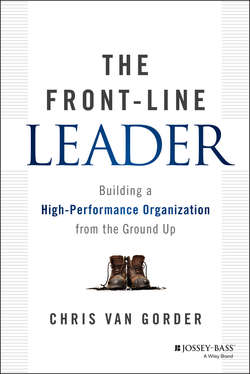Читать книгу The Front-Line Leader - Gorder Chris Van - Страница 10
На сайте Литреса книга снята с продажи.
Chapter One
Know Your People
Do Your Dance
ОглавлениеIt can be difficult to attribute a clear, quantitative business benefit to time spent on the front line or to any other tactic presented in this book; determining causality is just too complicated. The incredible financial and operational results we've seen at Scripps have resulted from many tactics working together over a period of years. Yet the physical presence of a leader is powerful – I know, because I've seen its effects firsthand.
In 1997, I left a position as CEO of Anaheim Memorial Hospital, a 240-bed facility, and took over as CEO of Long Beach Memorial Medical Center, a much larger, 700-bed facility. The Medical Center had a long central corridor that stretched from the Children's Hospital to the Women's Hospital all the way to the Rehabilitation Hospital and an attached skilled nursing facility. This corridor was so big that at any given time you might see hundreds of employees walking from place to place. What I noticed immediately upon joining Long Beach Memorial was that very few of the employees said hello to one another. They were all rushing, paying little attention. It was a huge difference from Anaheim Memorial, where everyone greeted each other by name.
Witnessing people walk right past one another made me uncomfortable, so I decided, in a small way, to do something about it. I began walking that corridor and saying hello to as many people as I could. This wasn't easy at first: because I was the new CEO, many people didn't recognize me. And because they walked with their heads down, staring at the floor, I literally had to duck down in order to make eye contact and say, “Hey there! How are you?”
I kept doing this, month after month. I also used these walks to rub scuff marks off the floor with my leather-bottomed shoe. After about a year, I began to notice a change. People were looking up more, even saying hello to me. More important, they were saying hello to one another. The whole atmosphere became friendlier. People began to joke about my habit of rubbing off scuff marks, calling my particular style of walking the “CEO walk.” Eventually one of my managers dubbed it the “Van Gorder dance.” Other employees and managers started doing the dance (which incidentally resulted in noticeably cleaner floors). The entire culture of this relatively large organization began to shift, perhaps in part because their leader had left the boardroom and was regularly engaging with the workforce.
Of course, there was more to that story. In a large organization, cultural change occurs only if everyone in a supervisory capacity walks the hallways and does their own versions of the Van Gorder dance. At Scripps, we now hold managers formally accountable for making rounds with their employees. It's part of their performance evaluation; if they don't do enough rounding, they miss out on some incentive compensation. This sends a message to managers, one that I hope you will heed as well. Face time with employees is something you need to do, not an option you might entertain. It's critical to the success of any team, department, or organization.
